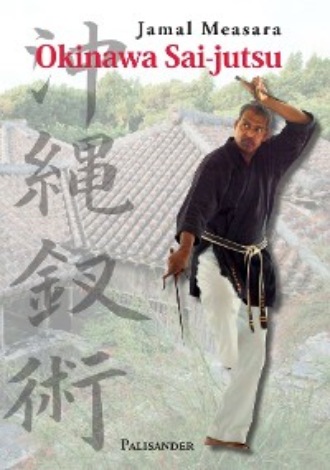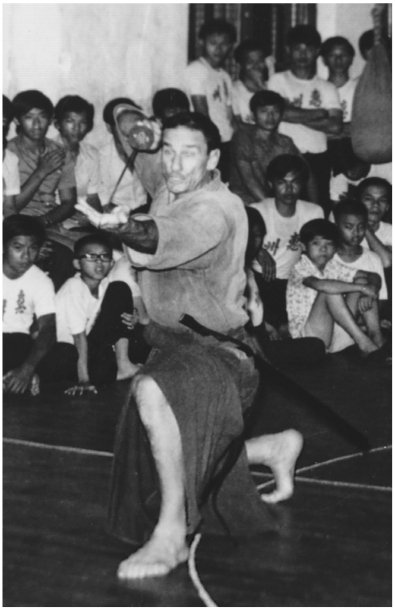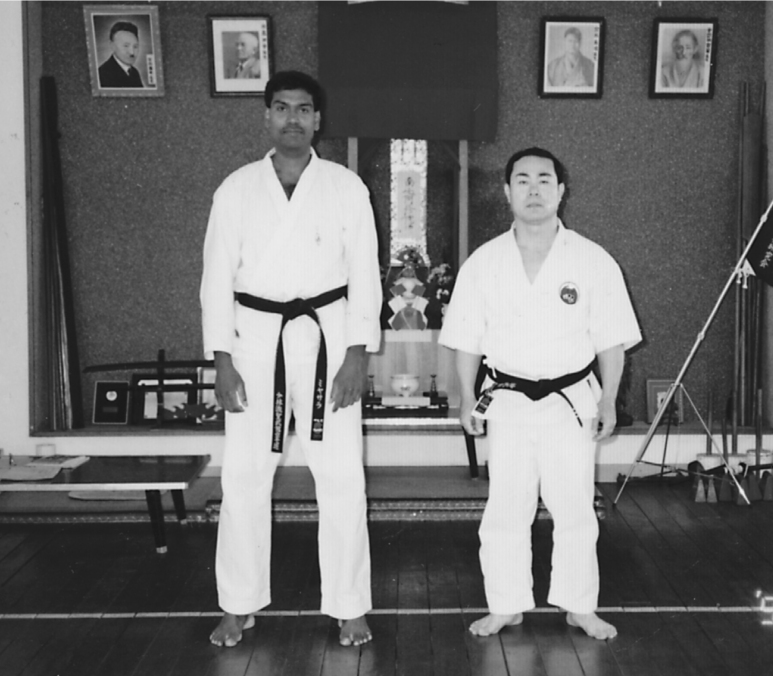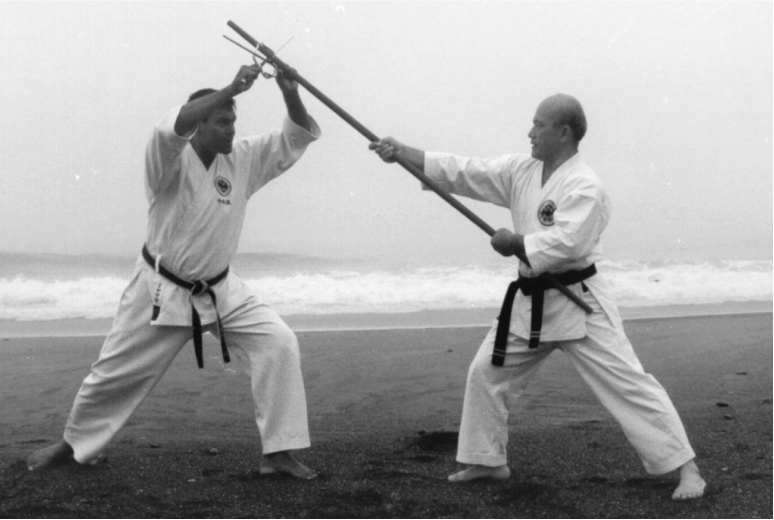
Полная версия
Okinawa Sai-jutsu

Jamal Measara
Okinawa Sai-jutsu
Palisander
Please note that neither the author nor the publisher of this book assume liability for any injuries or other consequences of any kind that may occur by following the instructions herein.
Der Verlag dankt Dr. Sven Hensel, Dr. Janett Kühnert und Norbert Wölfel vom Chemnitzer Karateverein für die fachliche Unterstützung bei der Redaktion.
Erstausgabe
1. Auflage Dezember 2012
© 2012 by Palisander Verlag, Chemnitz
Alle Rechte vorbehalten. Kein Teil des Werkes darf in irgendeiner Form (durch Fotografie, Mikrofilm oder ein anderes Verfahren) ohne schriftliche Genehmigung des Verlages reproduziert oder unter Verwendung elektronischer Systeme verarbeitet, vervielfältigt oder verbreitet werden.
Umschlaggestaltung: Anja Elstner, unter Verwendung der Fotografie »Nakamura House in Kitanakagusuku« von »663highland«, Wikimedia Commons, lizenziert unter Creative-Commons-Lizenz BY 2.5, URL: http://creativecommons.org/licenses/by/2.5/legalcode, einer Kalligraphie von Michiko Shimabukuro und einer Fotografie von Maximilian Rind
Lektorat: Frank Elstner
Redaktion & Layout: Frank Elstner
1. digitale Auflage: Zeilenwert GmbH 2015
ISBN 978-3-938305-91-1
www.palisander-verlag.de
Acknowledgement
I thank Kanei Hitoshi Sensei for the perpetuation of the heritage of his father Kanei Katsuyoshi Sensei, the founder of the Okinawa Jinbukan Kobudō. Furthermore, I thank Mrs. Shimabukuro for having made the calligraphy used on the cover of this book, Mr. Arnab Gosh, Mr. and Mrs. Muth and Mr. Iqbal Mohammed for the translation of the text, and Mr Ottmar Perras for acting as model on the photographs. I also thank Mrs. Monika Leupold for her great commitment. Without her comprehensive participation this book would not exist. I thank Mr. Alexander Börsch for his support, and also my wife Mrs. Heidemarie Measara, and all persons not mentioned who contributed in the creation of this work.
Illustrations
The author is the owner of the copyright of all illustrations used in this book.
Dedication
I would like to dedicate this book to my late beloved brother Kadir. It was he who had approached my cousin Pharok – a teacher of Silat Gayong, the Malaysian art of self defence – to teach me the art of the Tjabang (Sai). This was back in the 1960 s, when Pharok lived in the same city as me: Seremban, Malaysia. Even though that instruction was only for a short period of time, it was my first encounter with the Sai. Thank you, my brother, for whatever you have done for me.
Contents
Cover
Title
Imprint
Acknowledgement
Illustrations
Dedication
Author’s Note
Foreword
Preface
A Short Autobiograhical Notice
A Note on Martial Arts
Sai-jutsu
The Sai
Japanese Nomenclature of the Anatomy of the Sai
Safety Precautions with the Sai
The Rei – the bow
Tachi Gata – Stances
Mochi – Grips
Kihon – the Basics
Hojo Undō – Preparatory Exercises
The Kata
What I expect from a Budōka
Afterword
Glossary
Additional Books
Footnotes
Author’s Note
Before I even finished my third book – “Okinawan Bō-jutsu” – I had already started to plan my next book, which is the book you are reading now. I knew it would take me a long time to write this book, too. So, I thought of advertising it in “Okinawan Bō-jutsu”. Having done that, there was really no turning back. I left myself with no choice but to start working on this book before “Okinawan Bō-jutsu” was out of the press.
Enjoy the book, and train hard!
Foreword
I believe it must have been in the end of 1960 s when I saw a training and demonstration of master Jamal Measara in Seremban, Malaysia.
It was really amazing to watch him moving so full of energy, at the peak of his youth. I believe he must have been in his early 20 s, and I was around the age of 35.
His humour in training was great and his techniques were very sharp and strong, I could not help “falling in love” with this young gentleman and wanted to become his disciple and get to know him better.
Years passed by, and I lost sight of him, until 1978 when I was first introduced to him by a close friend. He stood face to face looking deep into my eyes. I can still remember that moment, it was a powerful look like that of a tiger ready to attack its prey. It made the strongest men weak, but at the same time his big brown eyes were also friendly, like that of an innocent child.
Even though I was teaching an old Indian Martial Art, Varma Kalai, passed on to me by my father, I wanted to give it up and start training under him. But my family was against this idea.
Anyway! By and by we became good friends. We met not very often, but at least twice a year.
In 1981 I came to know that master Jamal had left for Europe and I was deeply sorry for not taking the opportunity to have studied under him or at least to bid him farewell.
In August 20, 1996 I came to know that he was in Malaysia to visit the Silambam Association. I rushed to meet him and was heart-broken when I heard that he had left. I drove down to his home only to learn that he had already left for Germany. But with all the sad news I also had something that made me happy. That was his book on Karate. I was in tears with happiness to see this young man as a matured man.
I wrote to him the next day and to my surprise he remembered me well and promised to meet me in his next visit, and he did. He was the same gentlemen, but now with even more energy than before.
He presented me his books, I congratulated him on them. Jokingly he said: “Maybe you should write a foreword for my next book”. It would be a pleasure and great honour, I replied, not taking it seriously.
We talked for nearly five hours. It was the greatest joy of my life talking with this “living encyclopaedia”. During my conversation I could not help being in tears watching and hearing him speak on the topics of martial arts. One can feel the love he has for the tradition and the martial arts, and he hates seeing the tradition being modernized and destroyed. Before bidding him farewell, I awarded him the highest rank in Varma Kalai (“art of striking the vital points”). To my dismay he refused to accept it by saying humbly that he was not worthy of such a high rank. I understood what he meant. A man of his standing is seldom seen today in the world of martial arts. In May 2008 he wrote to me of his 4th book project, “Okinawan Saijutsu”. I was taken by surprise that he really had meant what he had said jokingly few years back. Thank you for accepting me as a close friend and giving me this honour to write my feelings in your book.
S. Rajagopal Naidu
Principal of Varma Kalai
Malaysia
June 2008
Preface
I am delighted to recommend Jamal Measara Sensei’s new book on Okinawan Sai-jutsu. Those readers who are serious practitioners and students of both the traditional and classical arts of the Ryūkyū Islands will gain true insight into the history, theory and use of the Sai – an implement long associated with the martial culture of the “Island of Propriety”1.
Measara Sensei is uniquely positioned to bring you this material due to his long-term successful efforts to learn and master not only the complex Karate-dō of Okinawa but also the separate but complementary art of Kobudō – a comprehensive art which includes Sai-jutsu. As an accomplished and well-known international instructor, Measara Sensei has not only demonstrated his skills in dōjō settings around the world but also has the ability to transmit his vast knowledge to readers of his books. He does this with great clarity by using well chosen words and high quality photographs which reflect accurate techniques. In this way he not only inspires others and passes on the correct way to use the Okinawan Sai but also preserves an important part of Okinawa’s martial culture, thereby fulfilling his duty to his mentors and their ancestors.
This is a book you will not only be glad you purchased but which you will be happy to recommend to your colleagues.
Bill Hayes
Major, U. S. Marine Corps (Retired)
“Old Student” of Okinawan Shobayashi-ryū Karate-dō
Fredericksburg, Virginia, USA
A Short Autobiograhical Notice

Fig. 1: Donn F. Draeger.
In each of my previous books – Okinawa Dento Karate-do, Karate Kata no Rekishi and Okinawan Bo-jutsu – my autobiographical notice is rather long, so I want to make it short in this one.
I was born in July, 1949, in Malaysia. I was brought up in a middle class family. At a very young age, I started learning the Indian martial arts of Silambam and Vajramushti. Later, I was taught “Western” boxing at the British army camp with which my father was associated.
After Malaysia’s independence from the British, I started weight training, and soon, got into karate. Due to circumstances, I was forced to change styles. I trained Shitō-ryū, Shōtōkan, Keishinkan, Budōkan, Gōjū-ryū, and a mix-up of the Malaysian Shōrin-ryū Seibukan Karate. I later changed the latter style to the “orthodox” Okinawan Shōrin-ryū Seibukan under the tutelage of Shimabukuro Zenpo Sensei. It is to this style that I still belong.

Fig. 2: Jamal Measara and Kanei Katsuyoshi.

Fig. 3: Jamal Measara with Sai and Shimabukuro Zenpo with Bō.
Later on, I also studied Kobudō, which was an equally mixed up mess in Malaysia; until I met Donn F. Draeger Sensei, who taught me the art of classical Kobujutsu. After he passed away in 1982, I studied Okinawan Kobujutsu under many sensei, such as Akamine and Matayoshi, until I met my sensei, Kanei Katsuyoshi, of Okinawan Jinbukan Kobudō. This is the style to which I still belong today.
I continued my Indian martial arts training, which I had stopped at a very young age back in the 1970 s, under Maha Guru Arumugam. I am still an advisor of his association.
During my Karate career, I participated in many semi-contact and full-contact tournaments. I was appointed National Coach of Malaysia until 1980, when I moved to Germany; which is where I still live now.
Конец ознакомительного фрагмента.
Текст предоставлен ООО «ЛитРес».
Прочитайте эту книгу целиком, купив полную легальную версию на ЛитРес.
Безопасно оплатить книгу можно банковской картой Visa, MasterCard, Maestro, со счета мобильного телефона, с платежного терминала, в салоне МТС или Связной, через PayPal, WebMoney, Яндекс.Деньги, QIWI Кошелек, бонусными картами или другим удобным Вам способом.

